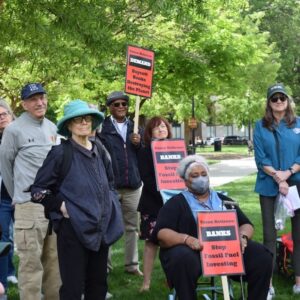October 14, 2014
Maintenance Defeats Improper Excessing
(This article appears in the November/December 2014 issue of The American Postal Worker magazine.)
Maintenance craft officers recently settled an important dispute, stipulating that the Postal Service cannot declare an installation “non-maintenance capable” and then use the designation to justify excessing Maintenance Craft employees who work on Building Equipment. The work at issue was primarily that of Building Equipment Mechanics (BEMs), although occasionally the duties are performed by other occupational groups, such as Level 7 Maintenance Mechanics (MM-7s) and Level 5 Building Maintenance Custodians.
The grievance arose when, after “consolidating” installations and removing all postal equipment, the USPS expanded the impact to the building side, writing, “This position is no longer authorized,” or, “The work will be shifted and coverage provided by the FMO [Field Maintenance Office].”
Management attempted to justify the excessing by claiming the facilities were no longer “maintenance capable.” The USPS further claimed that the MS-45 Handbook controlled the staffing and work assignments at the newly designated “non-maintenance capable” installations rather than the MS-1 Handbook, which controlled staffing when the installations were considered “maintenance capable.” (The Administrative Support Manual, by the way, says that if there are existing maintenance employees, the office is “maintenance capable.”) Since the BEMs were in fact present, the Postal Service claimed they could be excessed. This circular logic made management’s assertion a “red herring.” (“Red herring” means: a decoy, trick, ploy, lure, diversion, deviation or device.)
Management’s violation of Article 12 of the Collective Bargaining Agreement became clear.
The APWU asserted that whether an office was maintenance capable or not is irrelevant to determining whether employees can be excessed and forced from their duty assignments based on management’s unilateral assertion. Further, the fact that Level 9 BEMs were still assigned meant the installations met the definition of “maintenance capable.”
Since the Level 9 BEM was still assigned, under anyone’s definition of “maintenance capable,” the installation remained a maintenance capable office. Furthermore, the Postal Service’s reliance on the MS-45 Handbook was misplaced. The scope of the MS-45 Handbook is defined in Section 110:
“This handbook describes policies for the Field Maintenance Program (FMP). The FMP is designed to provide maintenance support to Associate Offices (AO), including the Stations and Branches of those AO’s, that are within a designated geographic area and are not maintenance capable or do not have employees with the requisite skill level.” [Emphasis added.]
Accordingly, the MS-45 Handbook can be utilized if there are no employees with the appropriate skill level in the installation. As long as the BEM (or possibly others) was assigned to the installation, the MS-45 could not be applied.
After the APWU succeeded in regional arbitration in the field on this issue, with other cases coming up, the USPS claimed the matter was an “interpretive dispute,” subject to national-level arbitration. This claim, as management intended, had the effect of locking up every field-level grievance on the issue until after a national-level arbitration decision could be rendered.
Working with the office of Director of Industrial Relations Tony McKinnon, we were successful in getting the national-level case scheduled for Sept. 23-24, 2014. As the date for arbitration approached, management agreed to settle the matter.
In accordance with the Sept. 15, 2014, settlement finalized by Director Steve Raymer:
- Where BEMs were excessed because management considered their facilities non-maintenance capable, an equal number of BEM assignments will be re-established. This will be done for the sole purpose of providing retreat rights to the excessed BEMs.
- BEMs who were excessed from their installation and/or craft as a result of the improper excessing will be paid $2,700 each, irrespective of their current duty assignment or whether they exercise their retreat rights.
- If there is only one BEM duty assignment in an installation and the BEM chooses not to return, Section 110 of the MS-45 will apply. (This is because the office will no longer have an employee with the requisite skill level.) In such cases, the single duty assignment may be reverted in accordance with Article 38 of the Collective Bargaining Agreement. In such cases, locals may request verification that an appropriate number of work hours have been transferred to the appropriate Field Maintenance Office (FMO).
- Regardless of the number of BEM duty assignments that are re-established, the MS-1 Handbook will apply. If the USPS must re-establish and return more BEMs than MS-1 staffing procedures call for, when those duty assignments become vacant, management may revert them. If fewer BEMs retreat to the duty assignments than the MS-1 staffing procedures call for in the installation, management must post and fill the BEM duty assignment(s) supported by the MS-1 staffing. In instances where an installation has only one excessed BEM and the BEM fails to retreat, Section 110 of the MS-45 will apply.
- Local cases that were delayed pending settlement of the dispute and that involve only BEMs will be resolved in accordance with the agreement.
The remedy is a one-time, non-precedent-setting agreement, which is intended to permit regional cases involving other occupational groups to adopt their own remedy.



